Content for TS 38.473 Word version: 18.2.0
8.6 System Information Procedures
8.6.1 System Information Delivery
8.7 Paging procedures
8.7.1 Paging
8.8 Trace Procedures
8.8.1 Trace Start
8.8.2 Deactivate Trace
8.8.3 Cell Traffic Trace
8.9 Radio Information Transfer procedures
8.9.1 DU-CU Radio Information Transfer
8.9.2 CU-DU Radio Information Transfer
...
...
8.6 System Information Procedures p. 92
8.6.1 System Information Delivery p. 92
8.6.1.1 General p. 92
The purpose of the System Information Delivery procedure is to command the gNB-DU to broadcast the requested Other SI. The procedure uses non-UE associated signalling.
8.6.1.2 Successful Operation p. 92
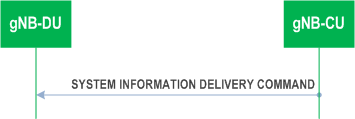
The gNB-CU initiates the procedure by sending a SYSTEM INFORMATION DELIVERY COMMAND message to the gNB-DU.
Upon reception of the SYSTEM INFORMATION DELIVERY COMMAND message, the gNB-DU shall broadcast the requested Other SI, and if the UE corresponding to the confirmed UE ID IE is not in RRC connected state, delete the UE context, if any.
Interactions with gNB-DU Configuration Update procedure:
Upon reception of SYSTEM INFORMATION DELIVERY COMMAND message, the gNB-DU Configuration Update procedure may be performed , and as part of such procedure the gNB-DU shall include the Dedicated SI Delivery Needed UE List IE in GNB-DU CONFIGURATION UPDATE message for UEs that are unable to receive system information from broadcast.
8.6.1.3 Abnormal Conditions p. 92
Not applicable.
8.7 Paging procedures p. 92
8.7.1 Paging p. 92
8.7.1.1 General p. 92
The purpose of the Paging procedure is used to provide the paging information to enable the gNB-DU to page a UE. The procedure uses non-UE associated signalling.
8.7.1.2 Successful Operation p. 93
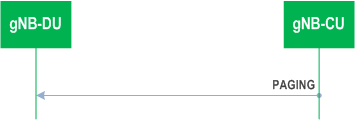
The gNB-CU initiates the procedure by sending a PAGING message.
The Paging DRX IE may be included in the PAGING message, and if present the gNB-DU may use it to determine the final paging cycle for the UE.
The Paging Priority IE may be included in the PAGING message, and if present the gNB-DU may use it according to TS 23.501.
At the reception of the PAGING message, the gNB-DU shall perform paging of the UE in cells which belong to cells as indicated in the Paging Cell List IE.
The Paging Origin IE may be included in the PAGING message, and if present the gNB-DU shall transfer it to the UE.
The RAN UE Paging DRX IE may be included in the PAGING message, and if present the gNB-DU may use it according to TS 38.304.
The CN UE Paging DRX IE may be included in the PAGING message, and if present the gNB-DU may use it according to TS 38.304.
The NR Paging eDRX Information IE may be included in the PAGING message, and if present the gNB-DU may use it according to TS 38.304.
The NR Paging eDRX Information for RRC INACTIVE IE may be included in the PAGING message, and if present the gNB-DU shall, if supported, use it according to TS 38.304.
The Paging Cause IE may be included in the PAGING message. If present the gNB-DU shall, if supported, send it to UE according to TS 38.331.
The PEIPS Assistance Information IE may be included in the PAGING message, and if present the gNB-DU shall, if supported, use it for paging subgrouping of the UE, as specified in TS 38.300.
The UEID Subgrouping Support Indication IE may be included in UE Paging Capability IE in the PAGING message, and if present the gNB-DU shall, if supported, use it for paging subgrouping of the UE, as specified in TS 38.300.
The RedCap Indication IE may be included in the UE Paging Capability IE in the PAGING message, and if present the gNB-DU shall, if supported, use it for paging of RedCap UEs.
The Last Used Cell Indication IE may be included in the Paging Cell Item IEs IE of the PAGING message, and if present the gNB-DU shall, if supported, consider the cell identified by the NR CGI IE as the last used cell of the paged UE, and use it as specified in TS 38.331.
The PEI Subgrouping Support Indication IE may be included in the Paging Cell Item IEs IE in the PAGING message, and if present the gNB-DU shall, if supported, consider that the cell identified by the NR CGI IE is supported by the UE to receive the paging early indication as described in TS 38.300 and TS 38.304.
The UE Paging Capability IE may be included in the PAGING message, and if present the gNB-DU shall, if supported, take it into account when paging the UE.
8.7.1.3 Abnormal Conditions p. 94
Not applicable.
8.8 Trace Procedures |R16| p. 94
8.8.1 Trace Start p. 94
8.8.1.1 General p. 94
The purpose of the Trace Start procedure is to allow the gNB-CU to request the gNB-DU to initiate a trace session for a UE. The procedure uses UE-associated signalling.
8.8.1.2 Successful Operation p. 94
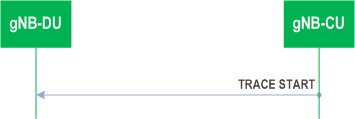
The gNB-CU initiates the procedure by sending a TRACE START message. Upon reception of the TRACE START message, the gNB-DU shall initiate the requested trace session for the requested UE, as described in TS 32.422. In particular, the gNB-DU shall, if supported:
- if the Trace Activation IE includes the MDT Activation IE set to "Immediate MDT and Trace" initiate the requested trace session and MDT session as described in TS 32.422;
- if the Trace Activation IE includes the MDT Activation IE set to "Immediate MDT Only" initiate the requested MDT session as described in TS 32.422 and the gNB-DU shall ignore Interfaces To Trace IE, and Trace Depth IE;
8.8.1.3 Abnormal Conditions p. 94
Void.
8.8.2 Deactivate Trace p. 95
8.8.2.1 General p. 95
The purpose of the Deactivate Trace procedure is to allow the gNB-CU to request the gNB-DU to stop the trace session for the indicated trace reference. The procedure uses UE-associated signalling.
8.8.2.2 Successful Operation p. 95
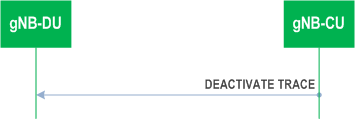
The gNB-CU initiates the procedure by sending a DEACTIVATE TRACE message. Upon reception of the DEACTIVATE TRACE message, the gNB-DU shall stop the trace session for the indicated trace reference contained in the Trace ID IE, as described in TS 32.422.
8.8.2.3 Abnormal Conditions p. 95
Void.
8.8.3 Cell Traffic Trace p. 95
8.8.3.1 General p. 95
The purpose of the Cell Traffic Trace procedure is to send the allocated Trace Recording Session Reference and the Trace Reference to the gNB-CU. The procedure uses UE-associated signalling.
8.8.3.2 Successful Operation p. 95
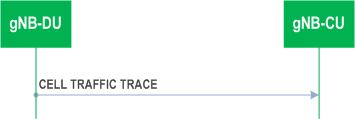
The procedure is initiated with a CELL TRAFFIC TRACE message sent from the gNB-DU to the gNB-CU.
If the Privacy Indicator IE is included in the message, the gNB-CU shall store the information so that it can be transferred towards the AMF.
8.8.3.3 Abnormal Conditions p. 95
Void.
8.9 Radio Information Transfer procedures |R16| p. 96
8.9.1 DU-CU Radio Information Transfer p. 96
8.9.1.1 General p. 96
The purpose of the DU-CU Radio Information Transfer procedure is to transfer radio-related information from the gNB-DU to the gNB-CU. The procedure uses non-UE-associated signalling.
8.9.1.2 Successful operation p. 96
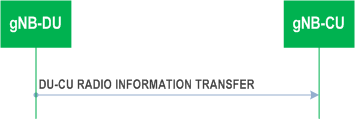
The gNB-DU initiates the procedure by sending the DU-CU RADIO INFORMATION TRANSFER message to the gNB-CU.
The gNB-CU considers that the RIM-RS Detection Status IE indicates the RIM-RS detection status of the cell identified by Aggressor Cell ID IE.
8.9.1.3 Abnormal Conditions p. 96
Not applicable.
8.9.2 CU-DU Radio Information Transfer p. 96
8.9.2.1 General p. 96
The purpose of the CU-DU Radio Information Transfer procedure is to transfer radio-related information from the gNB-CU to the gNB-DU. The procedure uses non-UE-associated signalling.
8.9.2.2 Successful operation p. 96
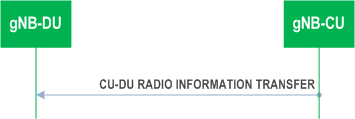
The gNB-CU initiates the procedure by sending the CU-DU RADIO INFORMATION TRANSFER message to the gNB-DU. The gNB-DU considers that the RIM-RS Detection Status IE indicates the detection status of RIM-RS associated with Victim gNB Set ID IE.
8.9.2.3 Abnormal Conditions p. 97
Not applicable.